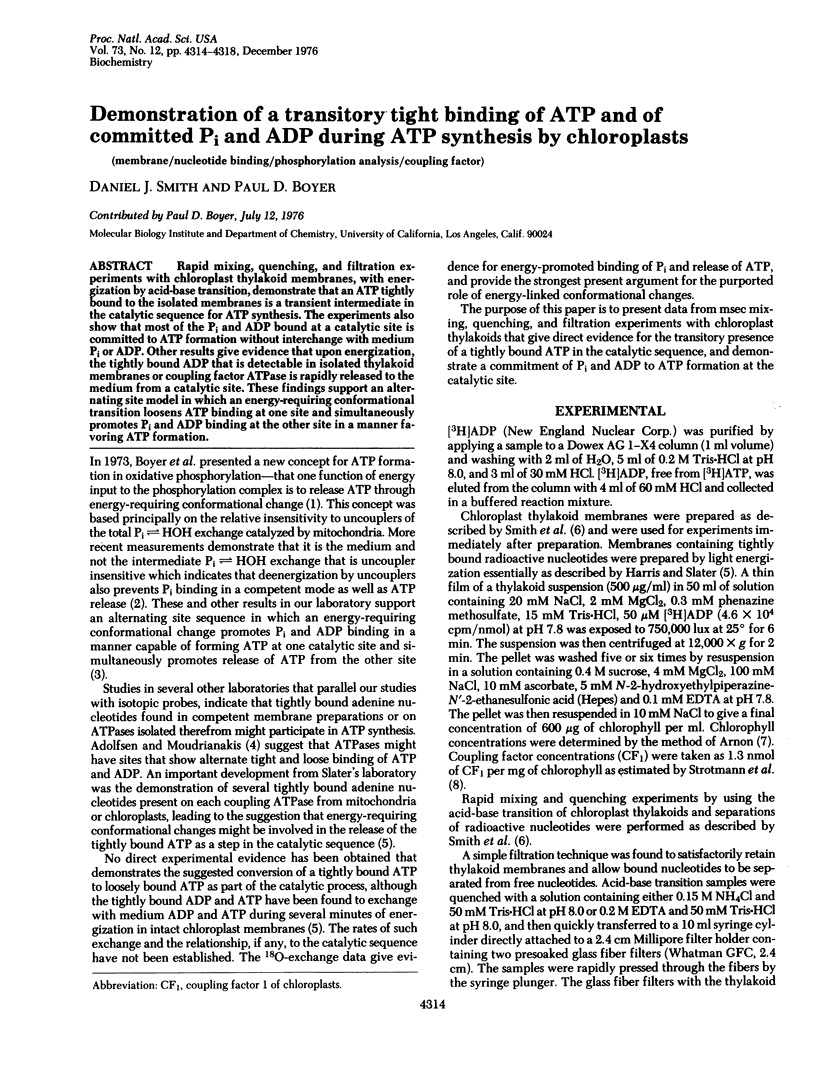Abstract
Rapid mixing, quenching, and filtration experiments with chloroplast thylakoid membranes, with energization by acid-base transition, demonstrate that an ATP tightly bound to the isolated membranes is a transient intermediate in the catalytic sequence for ATP synthesis. The experiments also show that most of the Pi and ADP bound at a catalytic site is committed to ATP formation without interchange with medium Pi or ADP. Other results give evidence that upon energization, the tightly bound ADP that is detectable in isolated thylakoid membranes or coupling factor ATPase is rapidly released to the medium from a catalytic site. These findings support an alternating site model in which an energy-requiring conformational transition loosens ATP binding at one site and simultaneously promotes Pi and ADP binding at the other site in a manner favoring ATP formation.
Keywords: membrane, nucleotide binding, phosphorylation analysis, coupling factor
Full text
PDF




Selected References
These references are in PubMed. This may not be the complete list of references from this article.
- Adolfsen R., Moudrianakis E. N. Binding of adenine nucleotides to the purified 13S coupling factor of bacterial oxidative phosphorylation. Arch Biochem Biophys. 1976 Feb;172(2):425–433. doi: 10.1016/0003-9861(76)90094-1. [DOI] [PubMed] [Google Scholar]
- Arnon D. I. COPPER ENZYMES IN ISOLATED CHLOROPLASTS. POLYPHENOLOXIDASE IN BETA VULGARIS. Plant Physiol. 1949 Jan;24(1):1–15. doi: 10.1104/pp.24.1.1. [DOI] [PMC free article] [PubMed] [Google Scholar]
- Boyer P. D., Cross R. L., Momsen W. A new concept for energy coupling in oxidative phosphorylation based on a molecular explanation of the oxygen exchange reactions. Proc Natl Acad Sci U S A. 1973 Oct;70(10):2837–2839. doi: 10.1073/pnas.70.10.2837. [DOI] [PMC free article] [PubMed] [Google Scholar]
- Farron F. Isolation and properties of a chloroplast coupling factor and heat-activated adenosine triphosphatase. Biochemistry. 1970 Sep 15;9(19):3823–3828. doi: 10.1021/bi00821a023. [DOI] [PubMed] [Google Scholar]
- Harris D. A., Slater E. D. Tightly bound nucleotides of the energy-transducing ATPase of chloroplasts and their role in photophosphorylation. Biochim Biophys Acta. 1975 May 15;387(2):335–348. doi: 10.1016/0005-2728(75)90114-0. [DOI] [PubMed] [Google Scholar]
- Magnusson R. P., McCarty R. E. Illumination of chloroplast thylakoids in the presence of ATP causes the binding of ADP to one of the large subunits of coupling factor 1. Biochem Biophys Res Commun. 1976 Jun 21;70(4):1283–1289. doi: 10.1016/0006-291x(76)91041-x. [DOI] [PubMed] [Google Scholar]
- Oleszko S., Moudrianakis E. N. The visualization of the photosynthetic coupling factor in embedded spinach chloroplasts. J Cell Biol. 1974 Dec;63(3):936–948. doi: 10.1083/jcb.63.3.936. [DOI] [PMC free article] [PubMed] [Google Scholar]
- Rosing J., Smith D. J., Kayalar C., Boyer P. D. Medium ADP and not ADP already tightly bound to phylakoid membranes forms the initial ATP in chloroplast phosphorylation. Biochem Biophys Res Commun. 1976 Sep 7;72(1):1–8. doi: 10.1016/0006-291x(76)90952-9. [DOI] [PubMed] [Google Scholar]
- Shavit N., Skye G. E., Boyer P. D. Occurrence and possible mechanism of 32P and 18O exchange reactions of photophosphorylation. J Biol Chem. 1967 Nov 10;242(21):5125–5130. [PubMed] [Google Scholar]
- Stokes B. O., Boyer P. D. Rapid transfer of oxygens from inorganic phosphate to glutamine catalyzed by Escherichia coli glutamine synthetase. J Biol Chem. 1976 Sep 25;251(18):5558–5564. [PubMed] [Google Scholar]
- Strotmann H., Hesse H., Edelmann K. Quantitative determination of coupling factor CF1 of chloroplasts. Biochim Biophys Acta. 1973 Aug 31;314(2):202–210. doi: 10.1016/0005-2728(73)90135-7. [DOI] [PubMed] [Google Scholar]


